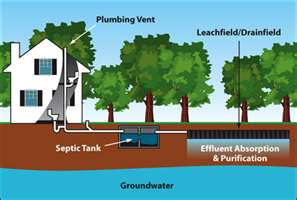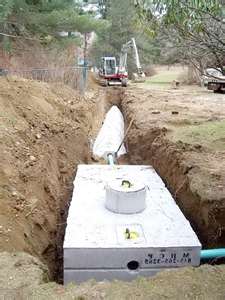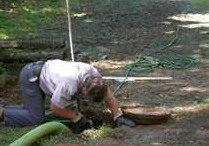|
|
|

|
SEPTIC SYSTEMS
On Lot
Sewage Disposal Systems, commonly referred to as septic systems, serve
about 25 million homes in the United States. A properly designed,
installed, and maintained septic system should last up to 50
years.
Unfortunately, there are many factors that will affect the lifespan of
a septic system. These include soil type, landscape position,
proper design and installation, amount of water used in the house, and
most important – maintenance of the system.
|
Many system drainfields fail
because of tree roots that grow
into the trenches seeking the highly organic nutrients and water. Other
systems fail because of leaking plumbing that overloads the septic
system drainfield or improper effluent that disrupts the biological
process of decomposition.
All septic systems will eventually reach their capacity to treat and
absorb wastewater. For this reason, it is important to properly
diagnose and repair any deficiencies immediately upon discovery. |

SOIL TESTING
The testing
for an on-lot sewage disposal system involves three steps.
The first is to locate at least two possible suitable areas for the
seepage bed. Some of the factors that help to determine site
suitability are slope of land, proximity to existing and future well
systems, boundary lines and rights of way issued to a third party,
presence of various plant species, tree root structure, etc.
The second is to conduct a probe. We will excavate the ground and
work with the Sewage Enforcement Officer to analyze the soil layers and
inspect the probe for evidence of soil mottling.
|

|
| The
third step is to conduct the percolation portion of the perk
test. A number of cylindrical holes will be dug and the time it
takes
for water to drain will be recorded. This will take several
readings
to obtain an average perc rate in an environment similar to that of a
saturated seepage bed. |

 |
SEPTIC DESIGN SERVICES
Utilizing
the data collected in the soil testing stage an on-lot sewage disposal
system can be designed. Some of the systems that can be used are:
- At Grade Bed Systems
- Drip Irrigation Systems
- Evapotranspiration Greenhouse Systems
- Peat Based Systems
- Elevated Sand Mound Type I
- Elevated Sand Mound Type II (Steep Slope)
- Eljen Systems
- Spray Irrigation
- Aerobic Tank Systems
|
| It
is our goal to design a system that is both economically
feasible and aesthetically pleasing. Many townships will permit
the
removal of an unsightly sand mound. Replacing the mound with an
alternate peat based system not only increases the lifespan of the
septic system it adds great value to your home by returning your yard
to a level terrain. |

SEPTIC MAINTENANCE
Having your
septic tank pumped every two years will add years to the life of the
system. Pumping out the septic tank is not only inexpensive it
permits the pumper to inspect the inlet and outlet baffles for any
breakage or misalignment.
Avoid flushing anything that wont dissolve in water. Active
bacteria is necessary for proper waste decomposition. This
bacteria can be killed by dumping improper chemicals down the
drain.
Avoid the gimmicky additives that promise to keep your system running
properly. Independent testing has proved that none of the septic
additives on the market increase the lifespan of a septic system.
|

|
|
|
|
Water Well
Repair, Septic Repair & Soil Testing, Water Quality and Purification
Water Well Contractors, Well Water Pumps, Well Drilling, Well Repair,
Septic Sytem, Absorption Systems / Septic System Drainfields and
more.
|
|





